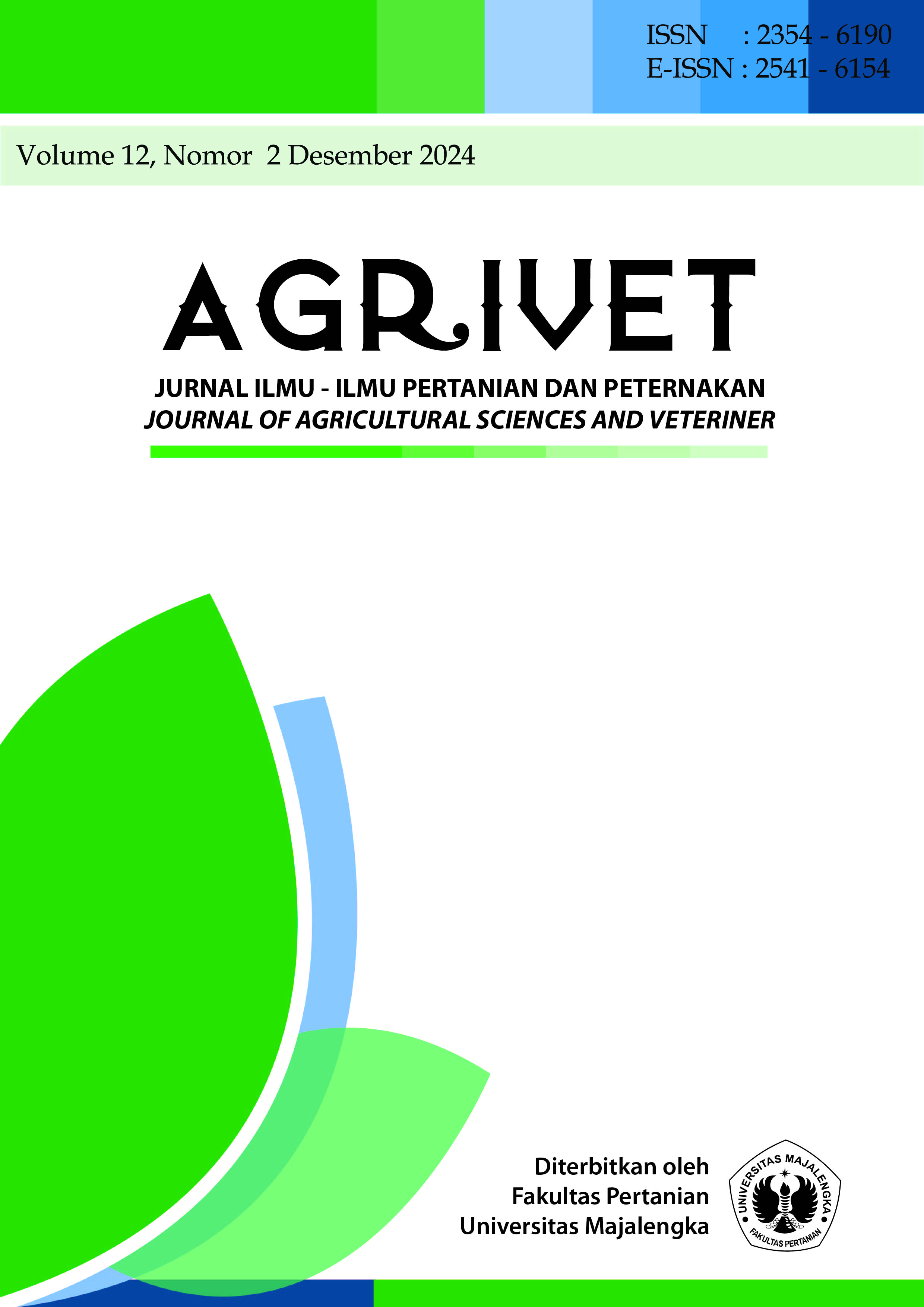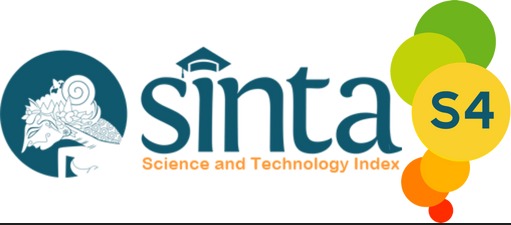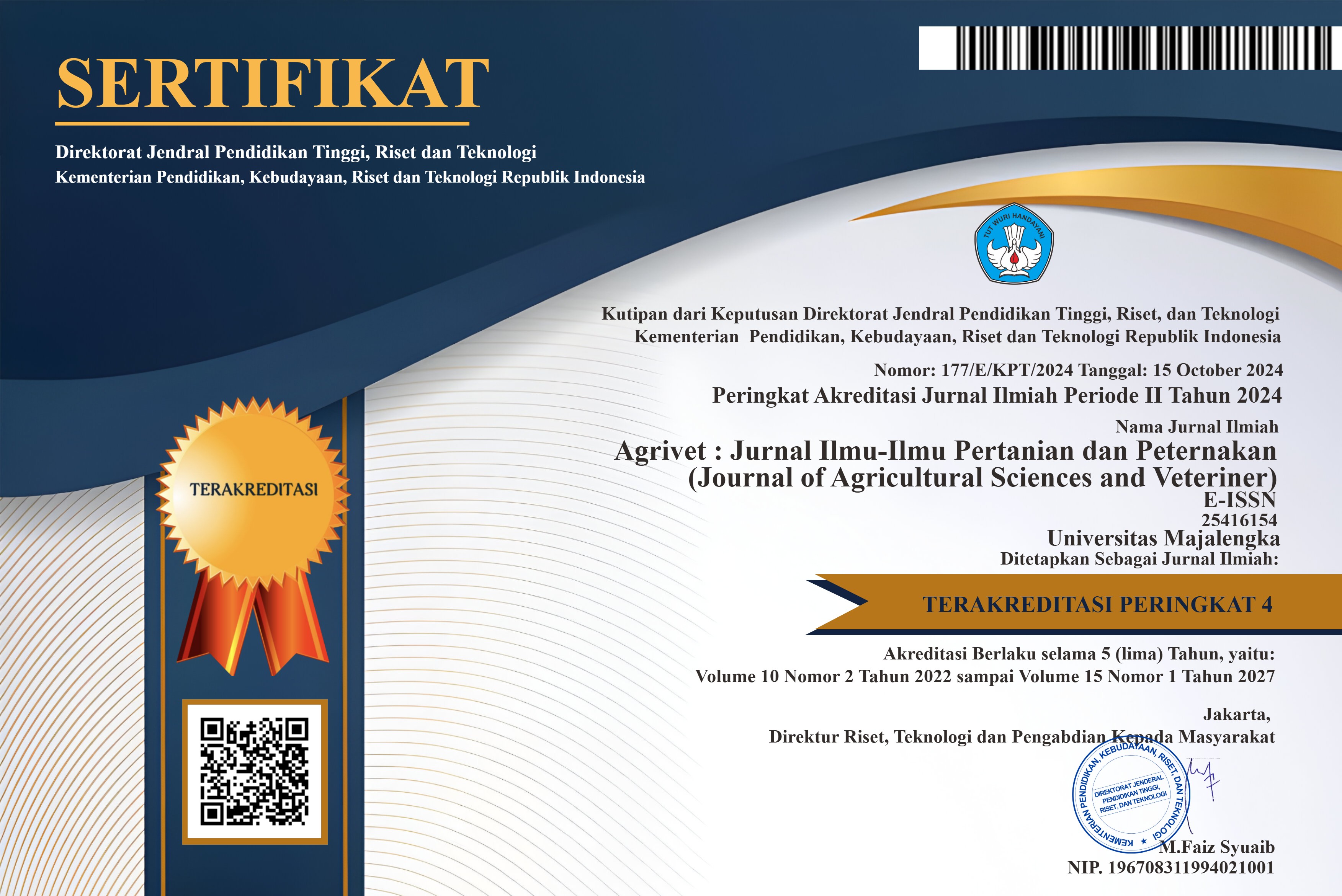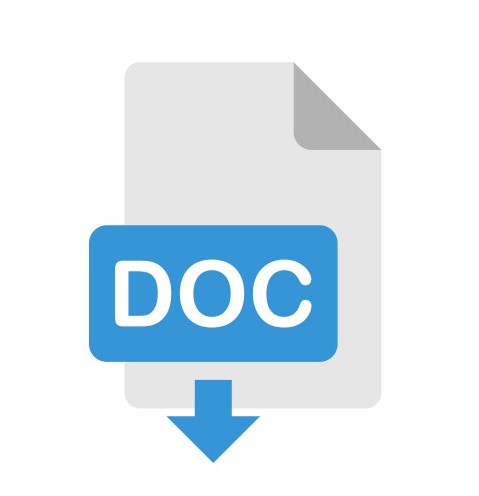Karakteristik peternak ruminansia di Binjai dan Bahorok, Sumatera Utara
DOI:
https://doi.org/10.31949/agrivet.v12i2.11540Abstract
Farmer characteristics are one factor influencing the productivity and development of livestock businesses. This research aims to determine the characteristics of ruminant breeders (cattle, sheep and goats) based on demographic factors in Binjai and Bahorok, Langkat Regency, North Sumatra Province. This research is qualitative descriptive research that used a survey method, which was carried out in May - June 2024. The research respondents were 75 surveyed from two city districts: Binjai and Bahorok. The characteristics of the breeders studied were the age of the farmers, the farmer's gender, the length of time they have been farming, the level of education, and the number of livestock cultivated. The data analysis technique used in this research is descriptive qualitative percentage analysis. The results showed that the majority of breeders were aged 31-50 years (65.3%), were male (97.3%), had been farming for more than 5 years (56%), had an education level of up to high school (73.3%), and the number of livestock kept 2 - 5 heads (27.3%). It can be concluded that beef cattle breeders in Binjai and Bahorok District are of a productive age, and the amount of livestock kept is still small.
Keywords:
Binjai and Bahorok, Characteristics of breeders, Ruminant LivestockDownloads
References
Andaruisworo, S. (2022, December). Karakteristik Peternak Sapi Potong di Kecamatan Badas Kabupaten Kediri Pasca Pandemi. In Prosiding Seminar Nasional Kesehatan, Sains dan Pembelajaran (Vol. 2, No. 1, pp. 17-27).
Ariani, M., Suryana, A., Suhartini, S. H., & Saliem, H. P. (2018). Keragaan konsumsi pangan hewani berdasarkan wilayah dan pendapatan di tingkat rumah tangga. Analisis Kebijakan Pertanian, 16(2), 147-163.
BPS. (2022). Produksi Daging Ternak Menurut Kabupaten/Kota dan Jenis Ternak (kg), 2020 dan 2021. https://sumut.bps.go.id/statictable/2022/03/17/2619/produksi-daging-ternak-menurut-kabupaten-kota-dan-jenis-ternak-kg-2020-dan-2021.html
BPS Bahorok. (2023). Kecamatan Bahorok Dalam Angka 2023. https://langkatkab.bps.go.id/id/publication/2023/09/26/5fe03a9440555a53cb22f956/kecamatan-bohorok-dalam-angka-2023.html
BPS Binjai. (2024). Kecamatan Binjai Utara Dalam Angka. BPS Kota Binjai. https://langkatkab.bps.go.id/id/publication/2024/09/26/778ab791a56c124515a20cac/kecamatan-binjai-dalam-angka-2024.html
Efu, A., & Simamora, T. (2021). Karakteristik peternak dan dukungan penyuluhan dalam mendukung kemampuan manajerial beternak sapi potong di Desa Oepuah Utara. AGRIMOR, 6(1), 22-26.
Elok, F. H. (2019). Persepsi Etis Mengenai Skandal Etika Auditor. In Search–Informatic, Science, Entrepreneur, Applied Art, Research, Humanism, 18(01), 105-117.
Hastang, Syahdar Baba, Aslina Asnawi, & Muhammad Ihsan Andi Dagong. (2018). Karakteristik Peternak Kambing Di Kecamatan Tamalatea, Kabupaten Jeneponto. Semnas Persepsi Iii Manado, 597–603
Hossain. 2022. Survei Pengetahuan, Sikap, dan Praktik Peternak Hewan Besar terhadap Penggunaan, Resistensi, dan Residu Antimikroba di Divisi Mymensingh Bangladesh. https://www.mdpi.com/2079-6382/11/4/442.
Indey, S., Saragih, E. W., & Santoso, B. (2022). Karakteristik Peternak Sapi di Sentra Produksi Ternak Potong Di Kabupaten Sorong. Jurnal Ilmu Peternakan Dan Veteriner Tropis (Journal of Tropical Animal and Veterinary Science), 11(3), 245. https://doi.org/10.46549/jipvet.v11i3.257
Pemerintah Kabupaten Bantul. 2023. Cegah stunting dengan konsumsi protein hewani. Diakses 10 Maret 2024. https://pusk-kretek.bantulkab.go.id/health-informations/hgnke-63-cegah-stunting-dengan-konsumsi-protein-hewani.
Ruth, D.H., Fauzul, A., dan Natalia, S. 2021. Analisis Efisiensi Usaha Peternakan Sapi Potong Rakyat di Tengah Pandemi Covid 19 di Kabupaten Langkat Sumatera Utara. Seminar Nasional dalam Rangka Dies Natalis ke-45 UNS. Universitas Quality Berastagi.
Sapta, A. (2022). Karakteristik Peternak sapi Potong di kecamatan Badas. Seminar Nasional Sains, Kesehatan, Dan Pembelajaran, 17–27.
Sari, Y. C., & Nanda, S. (2021). Karakteristik Peternak Sapi Pedaging di Kecamatan lareh Sago Halaban Kabupaten Lima Puluh Kota. Jurnal Ilmiah Peternakan Fakultas Peternakan Universitas Andalas, 3(2), 59–66.
Simanjuntak, R. A. (2012). Penilaian Faktor-Faktor Resiko Pada Saat Melakakukan Pekerjaan Dengan Metode Manual Tasks Risk Assessment. Prosiding Seminar Nasional Aplikasi Sains & Teknologi (SNAST) Periode III, November, 136–143.
Suwarta., Irham, Hartono S. 2012. Struktur Biaya dan Pendapatan Usaha Ternak Ayam Broiler di Kabupaten Sleman. Agrika 6(1): 66 - 85.
Simamora T, A.M. Fuah, A.Atabany, Burhanuddin. 2015. Evaluasi Aspek Teknis Peternakan Sapi Perah Rakyat di Kabupaten Karo Sumatera Utara. Jurnal Ilmu Produksi dan Teknologi Hasil Peternakan 3 (1) 52-58. https://journal.ipb.ac.id/index.php/ipthp /article/view/10814.
Yuniza, I., Sulystiati, M., & Mauludin, M. A. (2023). Karakteristik Peternak Domba Dalam Penerapan Good Farming Practice Di Desa Cinanjung Kecamatan Tanjungsari. Jurnal Ilmu dan Teknologi Peternakan, 11(2), 50-58.
Yesi, C.S., dan Syafri, N. 2021. Karakteristik Peternak Sapi Pedaging di Kecamatan Lareh Sago Halaban Kabupaten Lima Puluh Kota. Jurnal Ilmiah Peternakan Vol. 3 (2) : 59-66.
Published
How to Cite
Issue
Section
License
Copyright (c) 2024 Ikhwan Ma'arif, Rita Rosmala Dewi, Juli Mutiara Sihombing

This work is licensed under a Creative Commons Attribution-ShareAlike 4.0 International License.
An author who publishes in the Jurnal Agrivet agrees to the following terms:
- Author retains the copyright and grants the journal the right of first publication of the work simultaneously licensed under the Creative Commons Attribution-ShareAlike 4.0 License that allows others to share the work with an acknowledgment of the work's authorship and initial publication in this journal
- The author is able to enter into separate, additional contractual arrangements for the non-exclusive distribution of the journal's published version of the work (e.g., post it to an institutional repository or publish it in a book) with the acknowledgment of its initial publication in this journal.
- The author is permitted and encouraged to post his/her work online (e.g., in institutional repositories or on their website) prior to and during the submission process, as it can lead to productive exchanges, as well as earlier and greater citation of the published work









